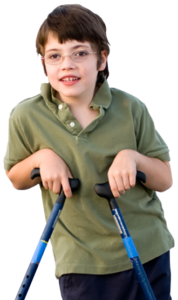Cerebral Palsy & Muscle Control
In most cases, the brain injury that causes cerebral palsy affects muscle control more than anything.
The most-prominent symptom of cerebral palsy is poor motor skills and muscle control. Sometimes, a child’s symptoms are much more pronounced in one part of their body than in others. For instance, they may have trouble controlling their legs but not their arms, or one side of the body may be more-affected than the other.

CP & Muscle Control
Motor Function
There are four main types of cerebral palsy based on motor function: spastic CP, athetoid CP, ataxic CP, and mixed CP.
- Spastic cerebral palsy (the most-common type) is characterized by increased muscle tone, meaning their muscles are stiff or tense.
- Athetoid cerebral palsy is characterized by unintentional or uncontrolled movements due to continually changing muscle tone.
- Ataxic cerebral palsy is characterized by a lack of coordination, balance and depth perception.
- Mixed cerebral palsy simply refers to a child who exhibits characteristics from more than one category.
As an able-bodied parent, imagine yourself trying to do something very precise, such as threading a needle. Now, imagine that every time you try to concentrate harder on threading that needle, your muscles start trembling more severely. This is a common symptom of cerebral palsy. The harder that a sufferer tries to do something, the more their muscles rebel against them.
Muscle Tone
Cerebral palsy is most-often categorized by either increased muscle tone (hypertonia) or decreased muscle tone (hypotonia).
Children with hypertonic cerebral palsy may exhibit trouble with balance, muscle contractures, awkward movements, and stiff limbs. Children with hypotonic cerebral palsy may exhibit “floppy” limb control, poor neck control, and an abnormal truncal tone.
Muscles of the Head and Face
Some children with CP have trouble controlling the muscles in the head and face, which can cause serious hearing, speech, and vision issues.
Difficulty with speech can make the child feel isolated and become frustrated due to an inability to express themselves, even though their inner dialogue may be very complex and rich.
Eating can also be a challenge for some kids with cerebral palsy, as they may have trouble chewing and swallowing, and may even require a special diet. To add to this, these children oftentimes have trouble with drooling as well, which can obviously be embarrassing socially. While most adults are fully understanding of the problem, that doesn’t mean that it’s not difficult to deal—especially when it comes to their peers.
About one third of individuals born with cerebral palsy also have some form of visual distortion due to poor muscle control of the eyes, and about 10 percent of all children with CP experience serious visual impairment.
